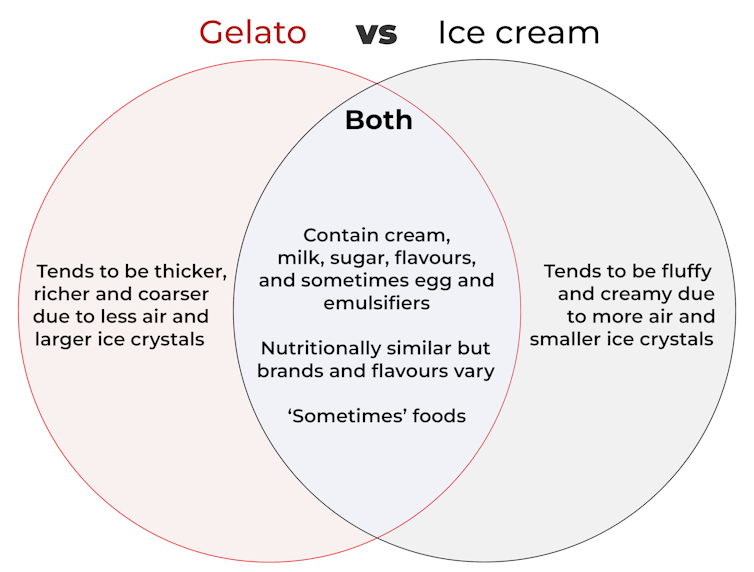
As the weather gets warmer, it’s the perfect time for ice cream or a gelato. Who am I kidding? It’s the perfect time year round.
But what’s the difference between gelato and ice cream?
Not everyone agrees. Some people say they’re made with different amounts of fat. Others say it’s all about the air content.
To add to the confusion, gelato is the Italian word for any type of ice cream. But in Australia, gelato refers to the frozen dessert of Italian origin.
How are they similar?
Ice cream and gelato are both sweet desserts served cold. They both contain varying amounts of cream, milk, sugar, flavours, and sometimes eggs.
The fat component from the cream provides the richness, smoothness and body. Eggs are normally associated with gelato but can also be added to ice cream to enhance the richness.
Most commercial ice creams and gelato also contain emulsifiers. These are food additives that act as a stabiliser by preventing liquids that normally don’t mix from separating. Emulsifiers have been linked to numerous gut symptoms. However most of the evidence comes from laboratory and animal studies, and there is limited robust evidence of this in humans.
Ice cream and gelato are both made by churning (whipping) the ingredients, leading to air bubbles forming. In fact, it’s the air bubbles that allow us to eat these desserts frozen. It gives them a palatable texture and mouthfeel by making the mixture softer and lighter. Imagine how hard it would be to eat a hard lump of frozen dessert.

Many people assume both ice cream and gelato are good sources of calcium, presumably because they’re made from dairy products. But due to the low proportions of milk (it’s mostly cream, which contains less calcium), they both only provide about 65 milligrams of calcium per half cup. That’s about 7% of the daily calcium requirements for adults aged 19-50.
They also both contain small amounts of protein – about 2-3 grams per half cup. That’s only about 5% of your daily protein requirements.
So ice cream and gelato are not a valuable source of calcium and protein, making them of low nutritional value. That’s why they’re regarded as “sometimes” foods.

How are they different?
It’s about the air
The speed at which the mixture is churned can determine the amount of air it contains. This impacts the product’s thickness and smoothness.
Ice cream is traditionally churned faster than gelato. This means more air is incorporated, making it feel fluffy and creamy compared to gelato, which tends to feels thicker and richer.
It’s about the ice
Churning at a slower speed, as you would typically for gelato, also increases the size of ice crystals. Large ice crystals give a coarse icy texture, compared to a creamier texture from smaller ice crystals in ice cream.
How about the fat?
Although many websites say ice cream contains more fat than gelato, this is a tricky one to tease out.
In Australia, food standards say ice cream should contain at least 100g milk fat per kilogram (or 10% milk fat).
So products with less fat need to be called something else – frozen dessert, iced confection, even gelato. So, in theory, a lower-fat product made the same way as ice cream could be called gelato. Non-dairy products made the same way as ice cream could also be called gelato.
So how much milk fat does gelato need to contain? I can’t find any legal requirements in Australia or elsewhere. Cooking websites often refer to it having 4-9% milk fat. But depending on the recipe, it could be higher.
Fat content also differs from flavour to flavour. For example, if you compare the nutritional content of half a cup of vanilla ice cream with half a cup of vanilla gelato, the ice cream has 2g more fat. Other flavours will give different results.
How about the sugar or kilojules?
If we just compare half a cup of vanilla ice cream with half a cup of vanilla gelato, the gelato has about 3g more sugar. Again, different flavours will give different results. The difference in kilojoules is very small – 15kJ per half cup.

Overall, which one’s healthier?
Effectively there is little difference nutritionally between ice cream and gelato.
But brands and flavours vary considerably. They each use different amounts of cream, eggs and other ingredients. So kilojoule, fat and sugar content can vary considerably too.
Should you still eat them? Yes, absolutely if you enjoy them. However, both are classified as sometimes foods due to their added sugar and low level of nutrients. And perhaps limit your serve size.
Evangeline Mantzioris is affiliated with Alliance for Research in Nutrition, Exercise and Activity (ARENA) at the University of South Australia. Evangeline Mantzioris has received funding from the National Health and Medical Research Council, and has been appointed to the National Health and Medical Research Council Dietary Guideline Expert Committee.
This article was originally published on The Conversation. Read the original article.







